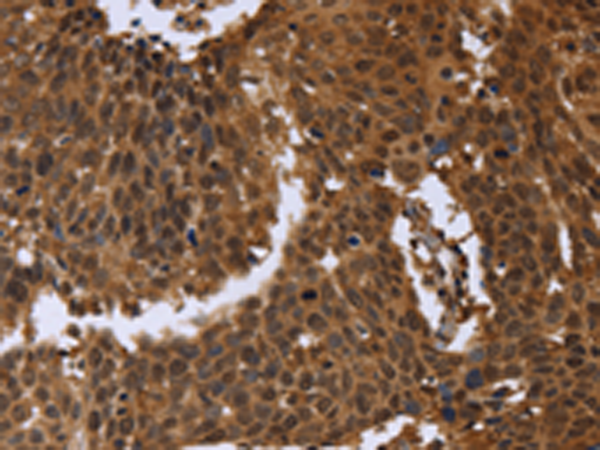


| WB | 咨询技术 | Human,Mouse,Rat |
| IF | 咨询技术 | Human,Mouse,Rat |
| IHC | 1/100-1/300 | Human,Mouse,Rat |
| ICC | 技术咨询 | Human,Mouse,Rat |
| FCM | 咨询技术 | Human,Mouse,Rat |
| Elisa | 1/2000-1/10000 | Human,Mouse,Rat |
| Aliases | FHFR; FGFR5 |
| WB Predicted band size | 55 kDa |
| Host/Isotype | Rabbit IgG |
| Antibody Type | Primary antibody |
| Storage | Store at 4°C short term. Aliquot and store at -20°C long term. Avoid freeze/thaw cycles. |
| Species Reactivity | Human, Mouse, Rat |
| Immunogen | Fusion protein of human FGFRL1 |
| Formulation | Purified antibody in PBS with 0.05% sodium azide and 50% glycerol. |
+ +
以下是关于FGFRL1抗体的3篇参考文献及其摘要概括:
1. **文献名称**:*FGFRL1 is a novel biomarker for lung adenocarcinoma progression*
**作者**:Zhang Y, et al.
**摘要**:该研究通过免疫组化(使用FGFRL1特异性抗体)发现,FGFRL1在肺腺癌组织中高表达,且与患者预后不良相关。实验证实抑制FGFRL1可降低癌细胞侵袭能力,提示其作为治疗靶点的潜力。
2. **文献名称**:*FGFRL1 regulates skeletal development through FGFR signaling modulation*
**作者**:Wang L, et al.
**摘要**:研究利用FGFRL1抗体进行小鼠胚胎组织定位分析,发现FGFRL1在软骨形成中关键作用。基因敲除小鼠显示骨骼发育异常,表明FGFRL1通过调控FGFR1信号通路影响骨骼生长。
3. **文献名称**:*Antibody-based targeting of FGFRL1 inhibits tumor growth in colorectal cancer models*
**作者**:Smith J, et al.
**摘要**:开发了一种新型FGFRL1单克隆抗体,体外实验显示其能阻断FGF信号传导并抑制结直肠癌细胞增殖。动物模型中,抗体治疗显著减小肿瘤体积,提示其作为靶向治疗的可行性。
4. **文献名称**:*FGFRL1 expression correlates with drug resistance in breast cancer*
**作者**:Chen X, et al.
**摘要**:通过Western blot和免疫荧光(使用抗FGFRL1抗体)发现,FGFRL1在三阴性乳腺癌耐药细胞系中上调。抑制FGFRL1可增强化疗药物敏感性,机制涉及MAPK通路调控。
以上文献涵盖了FGFRL1在癌症、发育及治疗中的应用,抗体主要用于检测表达、功能研究和靶向治疗验证。
**Background of FGFRL1 Antibody**
FGFRL1 (Fibroblast Growth Factor Receptor-Like 1) is a transmembrane protein belonging to the fibroblast growth factor receptor (FGFR) family. Unlike canonical FGFRs, FGFRL1 lacks a tyrosine kinase domain, suggesting a unique regulatory role in FGFR signaling pathways. It is implicated in modulating cell adhesion, differentiation, and embryonic development, particularly in skeletal and craniofacial morphogenesis.
FGFRL1 antibodies are essential tools for detecting and studying the protein's expression, localization, and function. These antibodies are commonly used in techniques such as Western blotting, immunohistochemistry (IHC), and immunofluorescence (IF) to investigate FGFRL1's role in physiological and pathological contexts. Research highlights its involvement in cancers (e.g., breast, lung) where aberrant FGFRL1 expression correlates with tumor progression and metastasis. Additionally, FGFRL1 mutations are linked to congenital disorders like craniofacial dysplasia.
Commercial FGFRL1 antibodies are typically raised against specific epitopes, often in rabbit or mouse hosts, and validated for specificity using knockout controls. Their applications extend to developmental biology, cancer research, and therapeutic target exploration. Ongoing studies aim to clarify FGFRL1's signaling mechanisms and its potential as a biomarker or drug target, driving demand for reliable antibodies in both basic and translational research.
(Word count: 198)
×